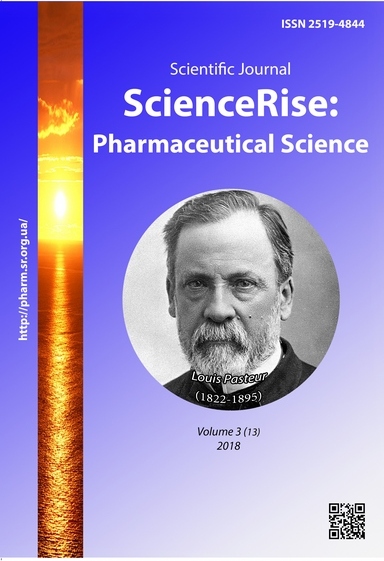Influence of extract of peach ordinary (persica vulgaris) leaves on the state of thymic-lymphatic element of the immune system of rats in conditions of chronic immobilization stress
DOI:
https://doi.org/10.15587/2519-4852.2018.135748Keywords:
thick extract peach ordinary leaves, chronic immobilization stress, thymus, spleen, stress-protective effectAbstract
The aim – study of the influence of thick extract of peach ordinary (Persica vulgaris) leaves (TEPL) on the state of thymic-lymphatic element of the immune system of rats in conditions of chronic immobilization stress.
Materials and methods. The model of chronic immobilization stress was reproduced for 18 days by daily four hour immobilization of rats in tight box. Investigated TEPL, which was obtained at the Department of Chemistry of Natural Compounds of National University of Pharmacy from peach leaves of the Salve variety harvested in Tajikistan was administered intragastrically in a conditionally effective dose of 100 mg/kg. Reference drug the syrup «Immuno-Ton» was used in a dose of 3 ml/kg. The state of thymic-lymphatic element of the immune system in conditions of chronic immobilization stress was determined after the euthanasia of animals under mild inhalation anesthesia by the results of the study of the coefficients of thymus and spleen mass and histological studies on micropreparations, which were prepared according to the generally accepted method. To assess the nature of the effect of the TEPL on the condition of the organs of the rat thymic-lymphatic system under chronic immobilization stress conditions, a comparison was made with intact control and control pathology.
Results. It was determined that chronic immobilization stress had suppressive effect on the thymic-lymphatic element of the immune system. An increase in the width of the marginal zone of lymphoid follicles and muft and the number of perivascular lymphatic clusters 1.2 times (p <0.05) compared with control pathology, reduction of signs of stressful hypoxia - the number of structures of white pulp with spasm of the central arteries was noted in the spleen. Reducing the degree of change from the third to fourth phase to the first phase of the accident transformation is set in the thymus, which is confirmed by an increase in the mass of the thymus mass by 2.7% in comparison with the control pathology.
Conclusions. The ability of TEPL to restore impaired activity of organs of thymic-lymphatic element of the immune system has been proved. It is likely, that polyphenolic compounds of TEPL exhibit antioxidant properties, enhancing the activity of the antioxidant system, and polysaccharides exhibit immunostimulative properties, the result of which is a stressprotective action. The effectiveness of TEPL was not inferior to the reference drug «Immuno-Ton»
References
- Kirichek, L. T., Perepelitsa, A. V., Kal'chuk, R. O. (2015). Lekarstvennyy antistress v eksperimente [Drug antistress in experiment]. Kharkiv: IPP «Kontrast», 104.
- Zhigulina, V. V. (2014). Biokhimicheskiy otvet organizma na stress (obzor literatury) [Biochemical response of the body to stress (literature review)]. Verkhnevolzhskiy meditsinskiy zhurnal, 12 (4), 25–30.
- Kurkin, V. A., Poroykov, V. V. (2015). Fenilpropanoidy lekarstvennykh rasteniy: prognoz antioksidantnoy i immunomoduliruyushhey aktivnosti [Phenylpropanoids of medicinal plants: prognosis of antioxidant and immunomodulating activity]. Sovremennye problemy nauki i obrazovaniya, 2 (2). Available at: https://www.science-education.ru/ru/article/view?id=22694
- Lipkan, G. N. (2014). Lekarstvennye rasteniya – adaptogeny [Medicinal plants – adaptogenes]. Kyiv, 686.
- Zaychenko, A. V. Sharifov, H. Sh., Stahorskaya, M. A., Haleeva, E. L., Navruzova G. N. (2014). Fitohimicheskoe obosnovanie farmakologicheskih effektov fenolnyih soedineniy persika obyiknovennogo [Phytochemical justification pharmacological effects phenolic compounds of peach]. Fіtoterapіya. Chasopis, 4, 71–74.
- Zaychenko, G., Sharifov, C., Mishchenko, O., Koshevaya, E. (2017). Influence of peach leaf extract on the metabolic processes and prooxidant/antioxidant balance in rats in conditions of chronic immobilization stress. ScienceRise: Pharmaceutical Science, 1 (5), 13–16. doi: http://doi.org/10.15587/2519-4852.2017.92521
- Lenchik, L. V., Navruzova, G. F., Kislichenko, V. S., Sharifov, H. Sh., Zaychenko, A. V. (2014). Fitokhimicheskoe i farmakologicheskoe izuchenie list'ev Persica vulgaris, zagotovlennykh v Tadzhikistane [Phytochemical and pharmacological study of Persica vulgaris leaves harvested in Tajikistan]. «Vestnik» of the South-Kazakhstan state pharmaceutical academy, 4 (3 (68)), 126–132.
- Stefanov, O. V. (Ed.) (2001). Doklinichni doslidzhennia likarskykh zasobiv [Preclinical studies of drugs]. Kyiv: Avicenna, 528.
- Sharifov, H. Sh., Zaychenko, A. V., Mischenko, O. Ya., Haleeva, E. L. (2017). Issledovanie aktoprotektornoy aktivnosti ekstrakta list'ev persika obyknovennogo [Investigation of the actoprotective activity of the extract of leaves of peach ordinary]. Dushanbe, 332–333.
- Ulanova, I. P., Sidorov, K. K., Khalepo, A. I. (1968). K voprosu ob uchete poverkhnosti tela eksperimental'nykh zhivotnykh pri toksikologicheskom issledovanii [On the question of taking the body surface of experimental animals into account in toxicological studies]. Toksikologiya novykh promyshlennykh khimicheskikh veshhestv, 10, 18–25.
- Bonashevskaya, T. I., Belyaeva, N. N., Kumpan, N. B., Panasik, L. V. (1984). Morfofunktsional'nye issledovaniya v gigiene [Morphofunctional studies in hygiene]. Moscow: Meditsina, 160.
- Directive 2010/63/EU of the European Parliament and of the Council of 22 September 2010 on the protection of animals used for scientific purposes (2010). Official Journal of the European Union, 276, 33–79.
- Lapach, S. N., Chubenko, A. V., Babich, P. N. (2000). Statisticheskie metody v mediko-biologicheskikh issledovaniyakh s ispol'zovaniem Excel [Statistical methods in biomedical research using Excel]. Kyiv: Morion, 320.
- Halafyan, A. A. (2007). STATISTICA 6. Statisticheskiy analiz dannykh [STATISTICA 6. Statistical analysis of data]. Moscow: Binom-Press, 512.
- Khem A., Kormak D. (1983). Gistologiya [Histology]. Moscow: Mir, 254.
Downloads
Published
How to Cite
Issue
Section
License
Copyright (c) 2018 Oksana Mishchenko, Ganna Zaychenko, Churshed Sharifov, Оlena Koshova, Julia Larianovskaya, Olena Khalieieva

This work is licensed under a Creative Commons Attribution 4.0 International License.
Our journal abides by the Creative Commons CC BY copyright rights and permissions for open access journals.








